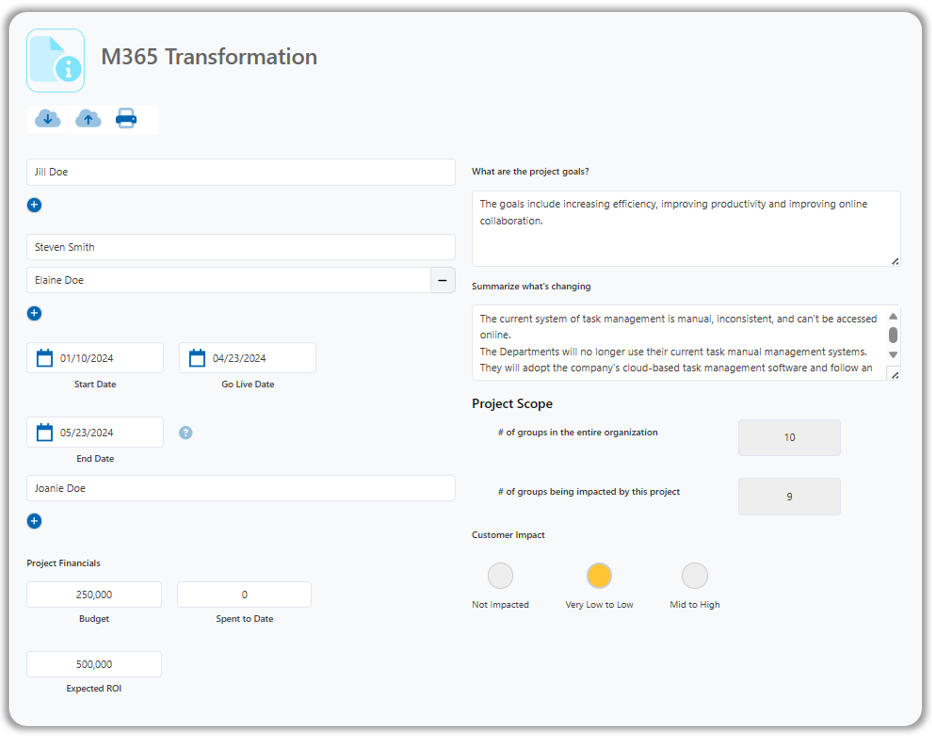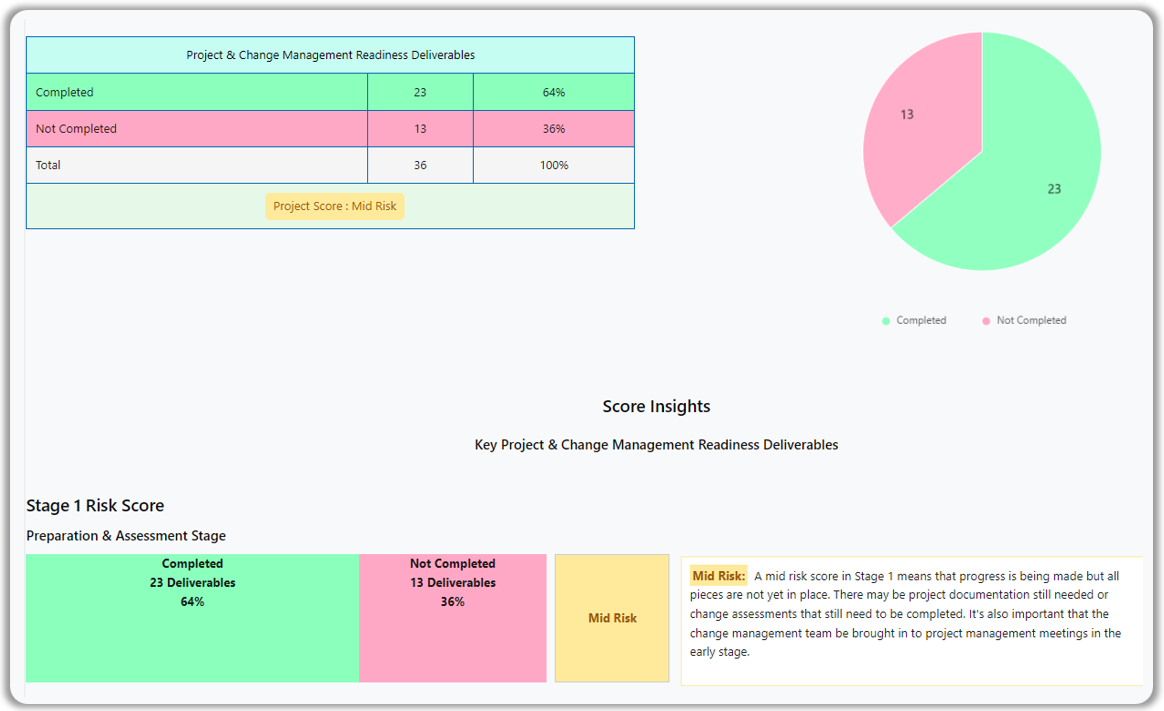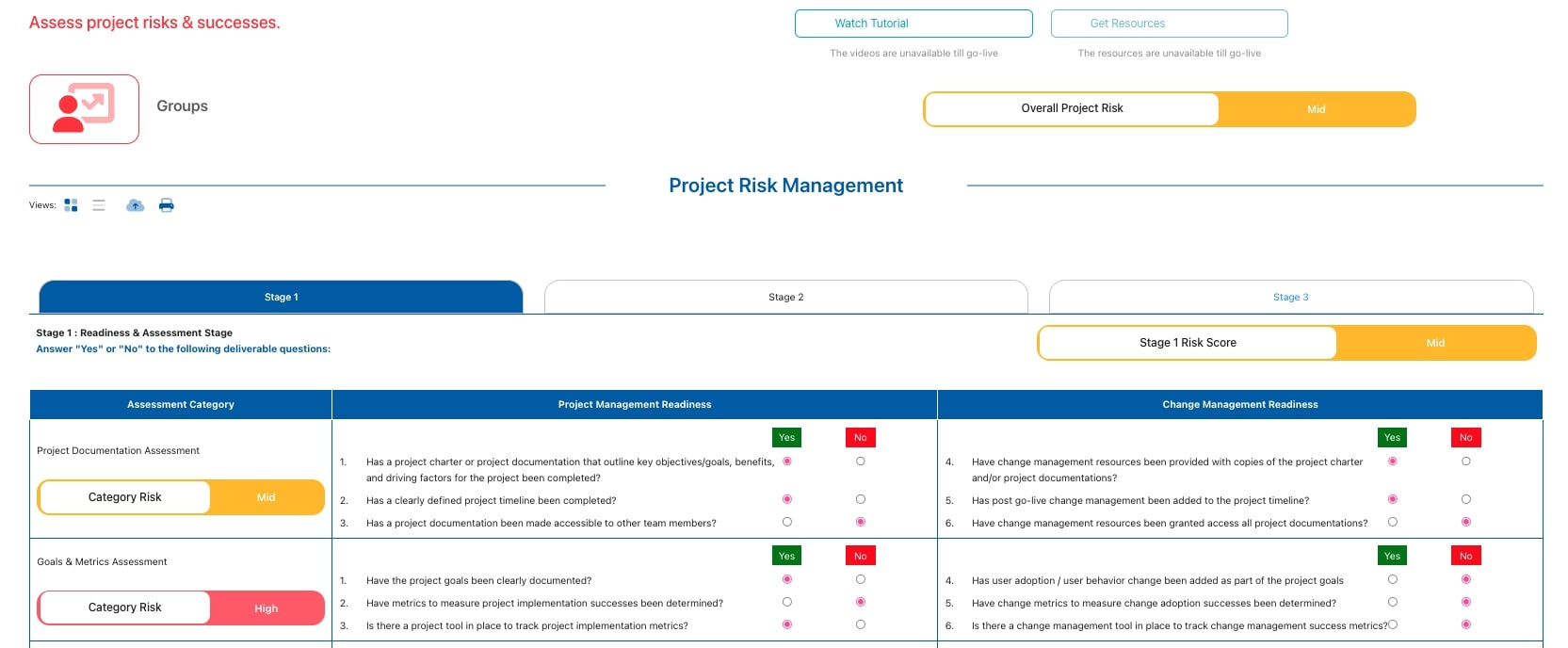Best Guide to Change Management Project Risk Analysis & Assessment to Increase Project Successes
Welcome to Your Change Management Project Success Guide!
Ever wondered what sets the stage for a successful project? It’s all about those crucial first steps. Imagine embarking on a journey without a map – that’s what diving into a project without a proper change and risk assessment feels like.
In this article, we’re delving deep into the world of project assessment in change management, a topic that is the heartbeat of any project’s success. Think of it as the warm-up before the marathon or the opening scene of a blockbuster movie – it’s where the tone is set, the foundation is laid, and the path to success is paved.
This article includes detailed project risk management examples and steps for assessing project risk as well as change management risk.
Enjoy a quick summary of project management self assessment below. If you want to dig into more information, keep reading for a detailed discussion of project risk analysis and project needs analysis.
Quick Summary
What is a Project Assessment?
A change management project risk assessment involves analyzing a project to understand its goals and evaluating its readiness to achieve key objectives. Project management self assessment and change management project risk analysis play a pivotal role in ensuring the success of change projects and their intended outcomes.
There are two types of project assessments: one to understand the project initially and another called a project needs analysis or project risk assessment, which is conducted multiple times to identify risks and areas of success. This approach helps project and change managers plan effectively for organizational solutions and requirements.
You can’t properly support the people and groups being impacted by a change initiative, if you don’t fully understand the details of that project. That’s what the first type of assessment is for. And you can’t keep the goal of successful audience adoption of the changes on track without continuing to assess the risk of that project. This is the purpose of the second type of project assessment. Next, we’ll look at both.
OCMS Portal – Learn & Excel in Project Assessments & Risk Analysis
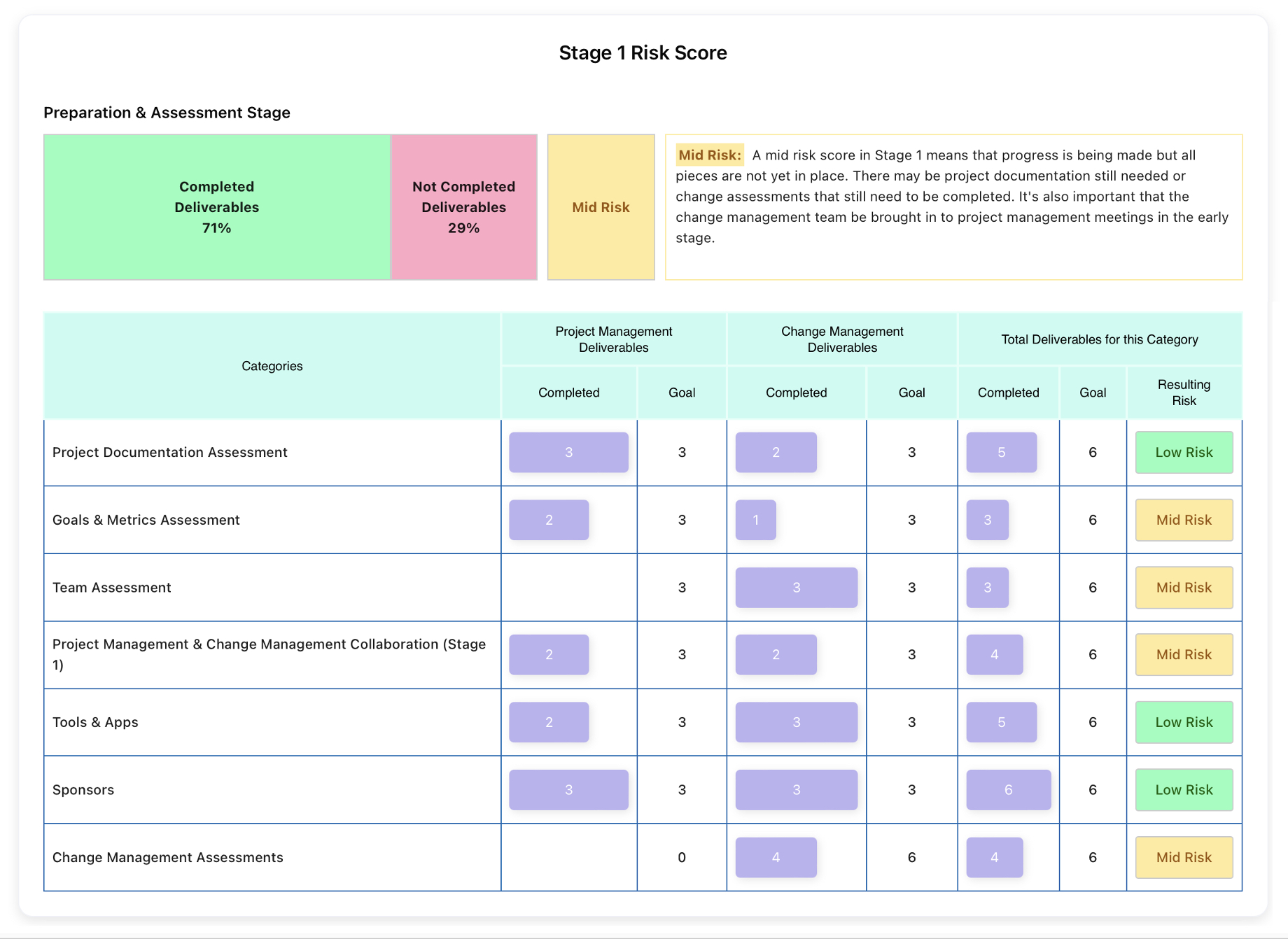
OCMS Portal is an end-to-end automated change management system that walks you through the project of project management self assessment and all the steps beyond. You’ll also find project risk management examples.
Project Assessment: Learning About a Project & Its Impacts
The first type of project assessment noted in the section above involves comprehensively understanding the project, encompassing its purpose, impact on employees and external stakeholders, success criteria, key milestones, timeline, and driving factors.
This initial assessment, conducted at the project’s onset, requires reviewing project documentation and engaging with project leaders and sponsors. Here are some of the key steps and a project criteria checklist you can use.
Conducting a Project Assessment:
- Schedule Meetings:
- Arrange individual meetings with project sponsor(s), managers, team members, stakeholders, and SMEs.
- Prefer 1-to-1 meetings for objective insights; consider group meetings if individual meetings are not feasible.
- Meeting Agenda:
- Focus discussions on understanding project background, scale, deliverables, and scope.
- Inquire about pain points, concerns, and challenges faced by participants.
- Request recommendations for additional individuals to meet regarding the project.
- Expand Meeting Scope:
- Schedule meetings with recommended individuals to gain comprehensive project insights.
- Document Requests:
- Obtain essential project documents from key leads (e.g., project charter, scope, WBS, timeline, RACI Matrix).
- Review Documents:
- Use project readiness checklist to assess documents and gather necessary information.
- Analysis and Documentation:
- Summarize findings and enter them into chosen project assessment tools (software, spreadsheet, template).
- Look for tools that also include project risk analysis based on a reputable change leadership model (like the OCMS change management framework or PCT assessment Prosci).
Are you leading or responsible for a mid-to-large project implementation? We can help.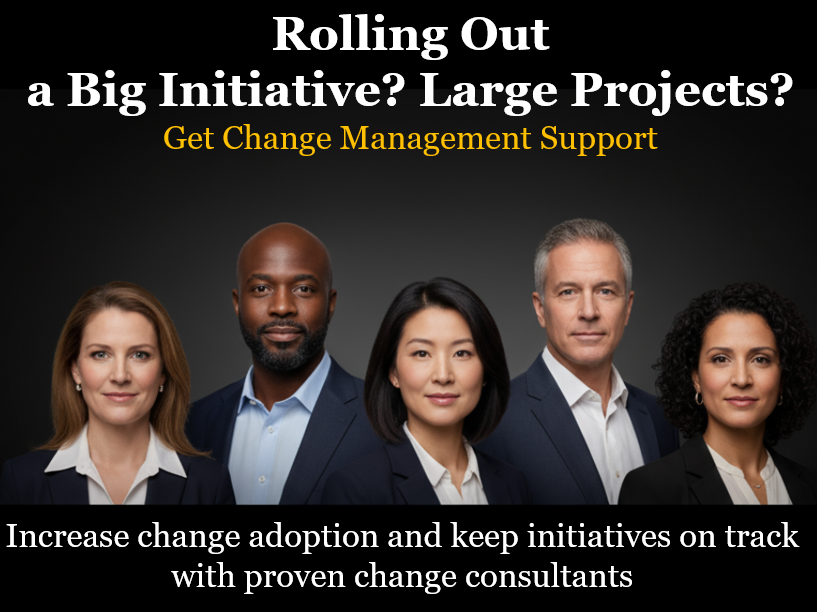 Learn more about how Airiodion Group can help you and your organization: Top Rated Change Management Consultants.
Learn more about how Airiodion Group can help you and your organization: Top Rated Change Management Consultants.
Do you have any questions about developing a project risk management plan or the analysis of risk in project management? Please reach out and let us know.
Project Risk Analysis: Tracking Risks & Successes
The second type of assessment we’ve discussed focuses on tracking project progress, identifying both risk areas and successes. This project risk management example involves evaluating project deliverables such as communications, training plans, and solution testing.
A thorough project risk analysis examines technical activities for solution delivery and change management strategies for end-user adoption. Performing this risk assessment of a project during three key stages (assessment, implementation, normalization) is essential to keep the project on track and prevent potential failures.
This risk assessment for a project acts as a proactive “temperature check” during both planning and implementation. It serves as a red flag mechanism, allowing project and change teams to address issues before they escalate, preventing late-stage problems that can jeopardize the project’s success.
Here is a rundown of when and what you should assess when tracking project risk:
- Stage 1: Learning & Assessment:
- Project Documentation:
- Project charter existence and sharing with change management team
- Presence of a project timeline
- Goals & Metrics:
- Clarity of project goals
- Availability of metrics for goal measurement
- Team Assessment:
- Presence of team leadership for both change management and project management
- Change Manager’s involvement in project planning
- Project manager’s understanding of the need for change management
- Tools & Apps:
- Use of digital tools for project deployment and adoption management
- Sponsorship:
- Presence of clearly defined and supportive sponsors
- Change Management:
- Completion of all change management assessments (impacts, stakeholder, readiness, etc.)
- Project Documentation:
- Stage 2: Planning & Deployment:
- Planning:
- Development and delivery of project plan
- Completion of change management plan
- Communications:
- Communication of project milestones
- Completion of the communications plan
- Task Execution:
- Tracking of tasks
- Delivery of ongoing reports
- Project Management & Change Management Collaboration:
- Coordination on deliverables between project and change management teams
- Go-Live Readiness:
- Monitoring go-live readiness
- Completion of end-user training
- Planning:
- Stage 3: Post-Go-Live Normalization:
- MPost-Go-Live Tracking:
- Establishment of user issue tracking mechanism post-go-live
- Issue Resolution:
- Adequate personnel availability for issue resolution
- Post-Go-Live Support:
- Presence of sufficient support resources for impacted end users
- Availability of additional training resources
- Project Management & Change Management Collaboration:
- Joint efforts to ensure normalization of required changes
- Lessons learned discussion between the teams
- Closure:
- Transfer of resources to permanent owners
- Completion of project-end tasks
- Normalization:
- Monitoring and addressing new resistance
- Verification of successful usage of the new solution by impacted groups
- MPost-Go-Live Tracking:
Please let us know if you have any questions about risk analysis in project management, creating a project risk management plan, or our project risk management example.
Get Your Free Trial of the Premier Change Management Software for end-to-end OCM.
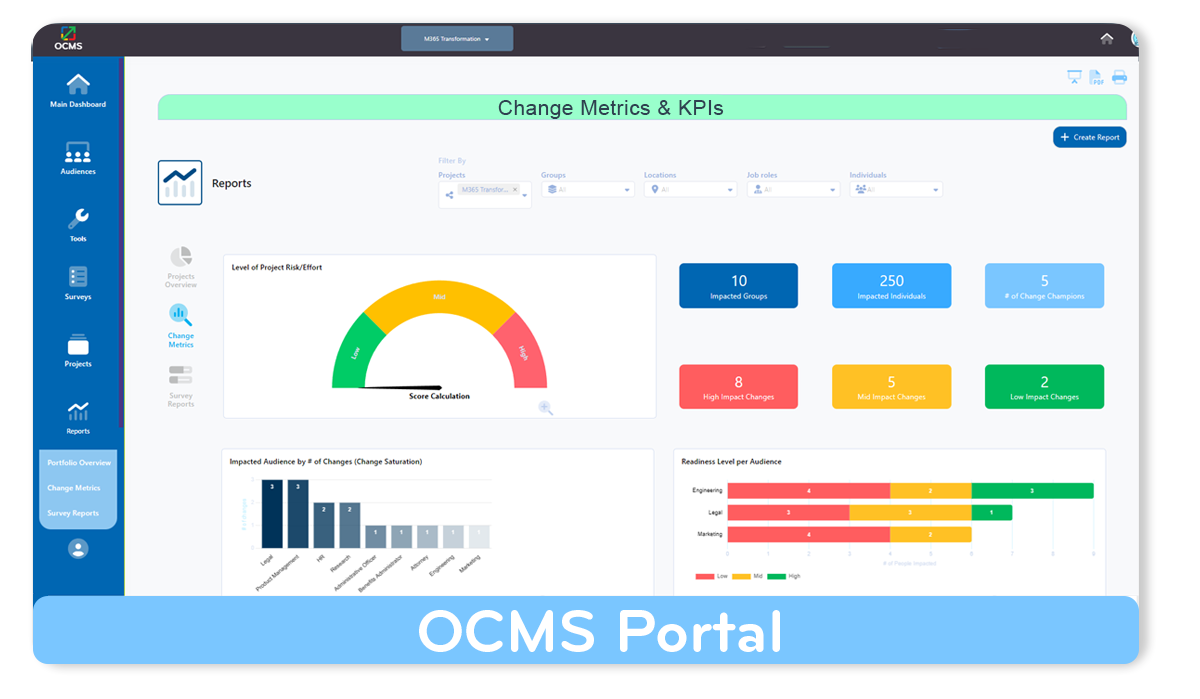
Looking for one tool that can handle all your change management assessments, analytics reporting, and project assessments and risk analysis? Sign up for a free trial of OCMS Portal today and level up your change management skills!
Conclusion: What Is Project Assessment?
In the grand tapestry of change management, the significance of a meticulous project assessment cannot be overstated. The careful evaluation of project documentation, seamless coordination between teams, and continuous monitoring post-go-live aren’t just checkboxes; they are the keystones upon which project success rests.
By understanding the nuances of project assessments, we empower ourselves to foresee challenges, optimize strategies, and ensure that every project not only takes flight but soars. As you embark on your own projects, remember, a solid beginning is the best assurance of a triumphant end.
Detailed Deep Dive
Complete Guide to Change Management Project Assessments | What You Need to Know
This change management & project management guide provides you with a step-by-step overview and everything you need to know for conducting the best change management project assessments and risk analysis. It includes key questions that you need to ask when analyzing a project to ensure you understand its parameters and objectives from a change management perspective.
Change management program assessment, risk assessment of a project, and project risk analysis are an important part of ensuring change projects are successful and achieve their desired outcomes.
Without a full understanding of a project upfront, and then conducting ongoing project needs assessment during implementation, change management projects have a high likelihood of failure.
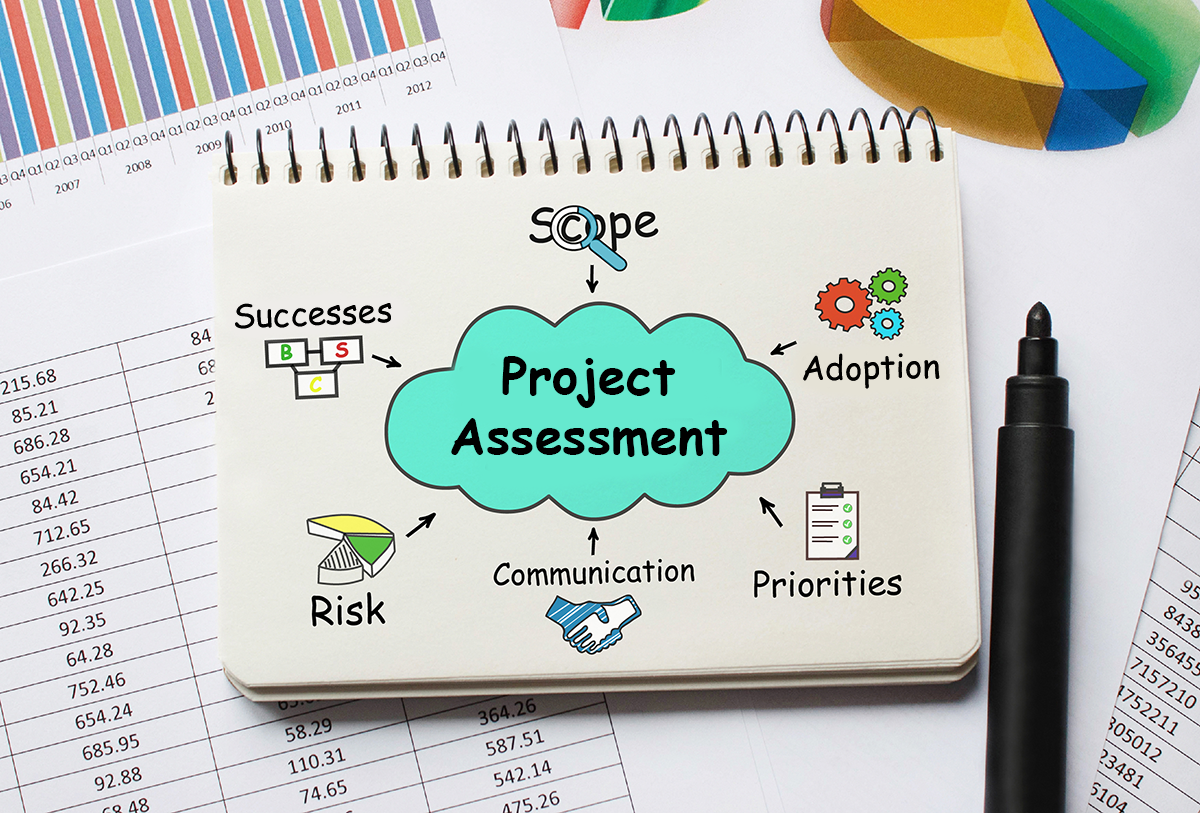
Program Assessments & Project Risk Analysis
According to recent studies, about forty-five percent of those leading and driving projects stated that the project’s objectives were not clear to them. If the change management project’s goals aren’t clear to project teams and change management teams, then how can they ensure a project is successful on both the “technical/deployment” side and the “people/adoption” side?
This free guide also includes change management project assessment examples of ongoing risk and success tracking for a business change management project, which is also vital to ensuring the project stays on track to not only achieve technically successful deployment but also to have end-users or employees adopting the new solution successfully.
We also reference the OCMS-based Change Management Prosci PCT assessment alternative project management self-assessment tool that you can use for your change program assessment needs.
Do you have any questions or feedback about assessing project risk, analysis of risk in project management, or developing a project risk management plan? Please reach out. We’d love to hear from you!
Table of Contents: Change Management Project Management Assessment Guide
Keep on scrolling down this page to read each section or click any link below to go directly to that section.
1. What is a Change Management Project Assessment?
a. Project Assessments for Learning
b. Project Assessments for Risk & Success
2. Gathering the Right Project Assessment Tools
3. Project Assessments to Learn About a Project
a. Why is it Important to Conduct a Project Assessment When First Joining a Project?
b. Project Assessment Checklist of Documents to Gather
i. What Project Documents Should You Gather or Request?
c. Questions to Ask Project Resources & Key Stakeholders
d. Project Assessment Example: How to Perform Your Assessment
e. What is a Project Assessment Report?
4. Project Assessments for Project Risk & Success
a. What Equates to Project Success? Or Project Risk?
b. Why Project Success Hinges on Project Management & Change Management Working Together
c. What is a Project Risk Analysis?
d. Why is it Important to Assess Project Risk & Success?
e. When Should You Assess a Project for Risk & Success?
f. How to Do a Risk/Success Needs Assessment in Project Management in 3 Stages
i. Stage 1: Readiness & Assessment
ii. Stage 2: Planning & Deployment
iii. Stage 3: Post-Go-Live Normalization
5. OCMS Portal – Software for Simple & Insightful Project Assessments for Risk & Success
6. Conclusion – Project Assessment Example & Metrics
7. FAQ: Project Evaluation Criteria Checklist & Guide
Do you have questions or feedback about this program assessment guide, PCT management, or project risk management examples? Please reach out and let us know. We’ll love to hear from you.
What is a Change Management Project Assessment (Definition)?
A change management project assessment is the process of analyzing a project to understand what the project is aiming to achieve, and then determine how ready the project is to achieve its key objectives.
Two types of project assessments should take place to give the project management team and change management team the best chance of success.
(1) The first type of project assessment is to learn about the project.
The focus of this initial project assessment is to learn about the project. It’s also something that change and project managers will do as they begin planning for a new solution or requirement for an organization.
(2) The second type of project assessment meaning is called a project needs analysis. This is a project assessment that is performed more than once to identify project risk as well as areas of success.
We’ll discuss both types of project assessment meaning below. In this project management assessment guide, we’ve separated the two types of project assessments into distinct sections.
Project Assessments for Learning About the Business Initiative
When a change manager or project manager joins a project, the first thing they need to do is understand all facets of that project. What is the project about? How does it impact employees or those external to the organization? What is considered “success” for the project? What are the key milestones? Timeline? Driving factors?
A review of project documentation and meetings with those leading and sponsoring the project will be necessary for this type of project timeline management assessment to learn everything you can about the project.
It’s impossible to provide effective change management without doing a project assessment first to learn about the project. This type of project assessment is typically done just once, at the start of the project.
The Project Essentials tool in the OCMS Portal guides you through the project assessment process.
Sign up for a free trial to use this tool, an impact analysis project management tool, and all the others you need for successful OCM support.
Project Assessments for Risk & Success
The second type of project assessment is performed to ensure a project is on track. It looks at both risk areas for a project, and areas that are going well (i.e., successes).
This project assessment example will include a review of project deliverables and identifying which have been provided and which haven’t. Such as communications, a training plan, final solution testing, etc.
Don’t Miss: Prosci PCT Model Alternative Tool for Change Managers
A good project risk analysis will look at both project management’s technical activities to deliver the solution, as well as change management’s people-based engagement for facilitating end-user adoption of the solution.
A project can easily go off the rails and fail if this project success and project risk analysis are not being done while the project is in progress. This type of project assessment will typically be done more than once. We recommend doing it at three key stages in a project.
Please reach out if you have any questions about risk assessment for a project, a project risk management example, or project risk management plan.
OCMS Portal Project Assessment Software
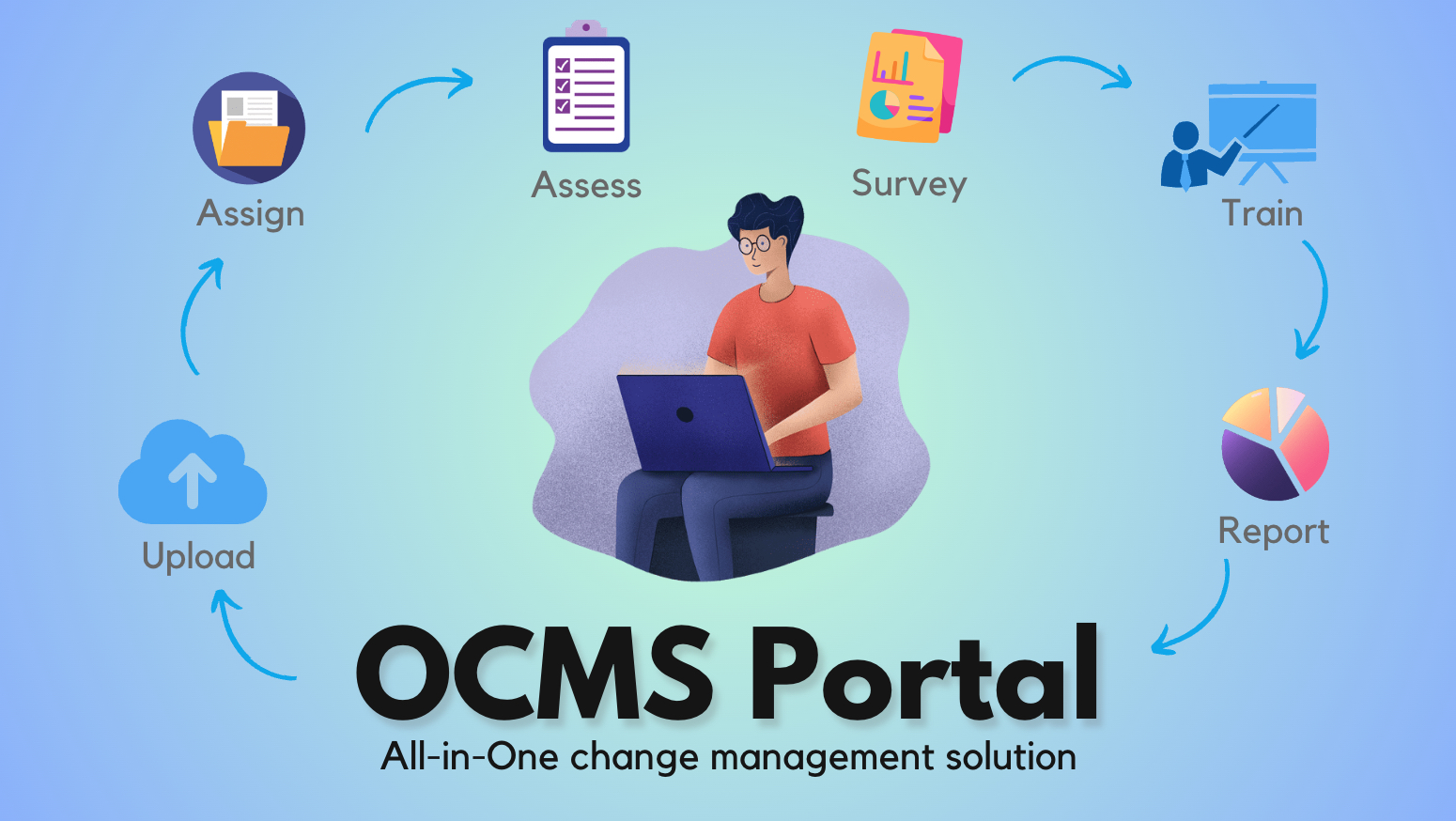
A best-in-class, comprehensive tool for project assessments & project risk analysis. Learn more!
If you’re looking for an alternate tool to the Prosci PCT assessment, and that can handle both types of project assessments described above, check out the OCMS Portal Project Assessment, Risk & Success Tools.
Gathering the Right Project Assessment Tools
Before you begin a risk impact analysis, project management self-assessment or a project assessment to learn the parameters of a new initiative, you should put the right tools and templates in place.
Having these project assessment tools before you get started, gives you a consolidated place to keep all your project assessment information. The right project assessment checklist or project readiness checklist can also guide you through the process of a project assessment to learn about a project.
Additionally, using project assessment tools, such as the OCMS Portal’s Project Assessment, Risk & Success Tool (a Prosci change triangle substitute), provides you with meaningful reporting and a project risk score that you can bring to meetings with others that are leading the project.
Look for project assessment tools that include:
- A way to capture all your project assessment task tracking (both types)
- A comprehensive project assessment checklist to follow
- A component for change management in the PMO assessment
- A project model in project management designed to look at both sides of project success (the deployment side and adoption side)
- A cloud-based platform for easy team collaboration
- Meaningful project needs analysis reports & analytics
- Onboarding to help you quickly get started with your project management self-assessment
- Automations that can calculate project success and project risk analysis scoring in both high-level and granular views
- Project assessment examples and sample data you can review
Alternative Prosci Change Triangle Tool for Change Managers
Screenshots from the OCMS Portal Project Management Assessment Tool’s Project Checklist
Checklist of Steps for a Project Assessment to Learn About a Project
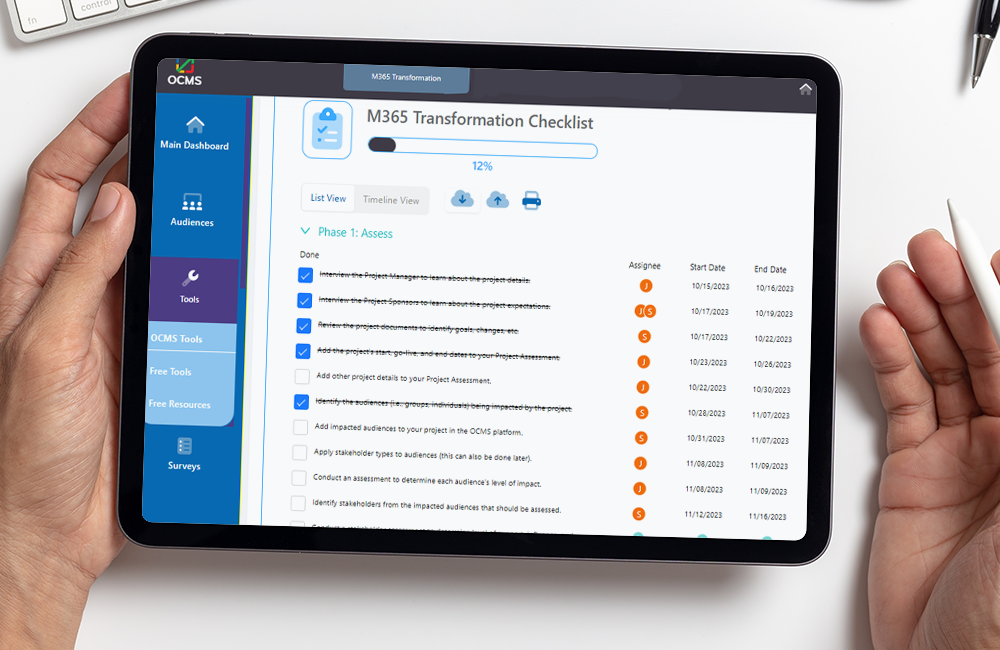
Did you just get assigned to do change management for a project? This project assessment checklist can help you get started.
Insightful Project Assessment Risk Reporting
The OCMS Portal’s Project Assessment Tool (an alternative to the Prosci project change triangle) shows you exactly where risk & success is in your project and what each score means in real terms.
Read More: OCMS Portal’s Program Analysis Toolkit for Change Practitioner (A Prosci PCT Model Substitute)
Next, we are going to review the two main types of project assessments that we’ve discussed in the sections above.
First, we’ll review the program assessment done to learn about a project and all its parameters. Then, we’ll get into project needs assessment to review the risk and success of a project while it’s in progress.
Do you have any questions about an impact analysis project management assessment or alternative ways to assess project risk instead of the Prosci PCT model? Please reach out and let us know.
Project Assessments to Learn About a Project
Why is it Important to Conduct a Project Assessment When First Joining a Project?
When you initially join a project or business program as a Change Manager, Program Manager, or Project Manager, your first priority will be to conduct a thorough review of the project or program. This needs to be done before (or in parallel to) conducting a stakeholder assessment, a change impact analysis, and a change readiness assessment.
The goal of conducting a project management assessment is to understand the scope, scale, timeline, and overall objectives of the program. This knowledge then allows you to better develop and implement the project management deliverables or the change management deliverables that are critical to support the project and make it successful.
Without doing a project complexity assessment, you will always be one step behind, and will always be playing catch-up, including during meetings. This is not an ideal state for you if you are a Project Manager, Lead, Program Manager, or Change Manager that has been assigned to a new or an existing project.
Don’t Miss: End-to-End Tool for Conducting Best Project Assessments
Project Assessment Checklist of Documents to Gather
Doing a project timeline management assessment and project assessment involves understanding and documenting the nature of the change that the project is looking to implement.
This involves assessing the project scope, scale, designs, program objectives, and factors driving the need for the company to implement the change now. It also includes assessing the project:
- Deliverables (design-build-test-deploy)
- Milestones
- Problem statements
- Statement of Work (SoW)
- The expected solutions
- The risks of not changing now
- Defined success
- Change leadership model that will be used for the project
Conducting a project analysis using a change leadership model or project assessment example also includes understanding the project’s implementation governance (the “who’s who”?).
What Project Documents Should You Gather or Request?
If you’re a change manager, you may find yourself in a position of being asked to provide change management for a project, but never being given much information about the project.
You need more than just a general description of what the project is about. This is why you should use a project evaluation criteria checklist or project assessment checklist of some type as guidance for the types of documents you need to request if you don’t already have them.
Here’s a project assessment example checklist of what to request from the project management team:
- Project Charter: This document outlines the project’s high-level objectives, scope, stakeholders, and overall approach. It provides an essential foundation for understanding the project’s purpose and alignment with organizational goals.
- Project Plan: The project plan details the project’s timeline, key milestones, deliverables, and dependencies. It helps you understand the project’s schedule and how the change management activities can be integrated into the overall plan.
- Stakeholder Analysis: Request any stakeholder analysis or assessments that have been conducted. This will help you identify key stakeholders, understand their interests, and anticipate potential resistance or support for the changes.
- Communication Plan: The communication plan outlines how information is disseminated to stakeholders and team members. Understanding this plan will help you align your change management communication efforts with the overall project’s communication strategy.
- Risk Register: The risk register lists identified project risks and their potential impacts. It is crucial to be aware of any risks related to the changes being implemented, as they may require targeted change management strategies.
- Change Management Plan: Request any existing change management plans or strategies that have been developed. This will help you understand the current approach and align your efforts accordingly.
- Project Team Information: Obtain information about the project team members, their roles, and responsibilities. Understanding the team dynamics can help you build rapport and foster collaboration.
- Previous Project Reports: Request any reports or meeting minutes from previous project updates or status meetings. These documents can provide insights into past decisions, challenges, and progress.
- Organizational Policies and Procedures: Request any relevant organizational policies and procedures that may impact the changes being implemented. Understanding these policies will ensure compliance and alignment with the organization’s guidelines.
- Lessons Learned: If available, review lessons learned from previous projects or change initiatives. These insights can offer valuable guidance and help you avoid potential pitfalls.
- Key Performance Indicators (KPIs): Obtain information about the project’s KPIs and metrics used to measure success. This will help you align your change management efforts with the project’s objectives.
By requesting these project documents, you can quickly get up to speed on the project’s status, challenges, and goals. This information will enable you to develop a tailored change management strategy that aligns with the project’s needs and maximizes the chances of successful implementation.
It’s important to note that not all of the documents in the above project evaluation criteria checklist may be available for all projects.
What is a project assessment’s most important document?
If there is one that is the most important for the change management team and project management team to review before getting started, it’s the project charter.
Let us know if you have any questions about risk assessment of a project, a project complexity assessment, an equivalent for the Prosci PCT assessment template, or a PMO assessment as described in this guide.
Questions to Ask Project Resources & Key Stakeholders
In addition to reviewing project documentation to assess a project for learning purposes, you should also speak with those that are leading or sponsoring the project, including the program managers.
When meeting with the primary sponsor(s), project managers, program leads, and other key stakeholders for your project management assessment, the list below will guide you in asking the pertinent questions needed to understand the type of change, the size of the change, what is changing, and other critical project scope questions.
Project Assessment Examples of Questions to Ask:
- What type of change is this? (Is it a process change? Systems change? Organizational culture change?)
- What are the goals, objectives, and key aims of the project?
- What are the key milestones and project deliverables?
- Who are the main stakeholders and impacted groups?
- Are there any known resistance or change resistors?
- What are the project risks? Is there an existing risk/issues log?
- Are there any lessons learned since the program was initiated?
- What are the known pain points, challenges, and concerns?
- Who else should I speak to as I ramp up on this project?
- Are there any existing or potential resistance points?
- and many more
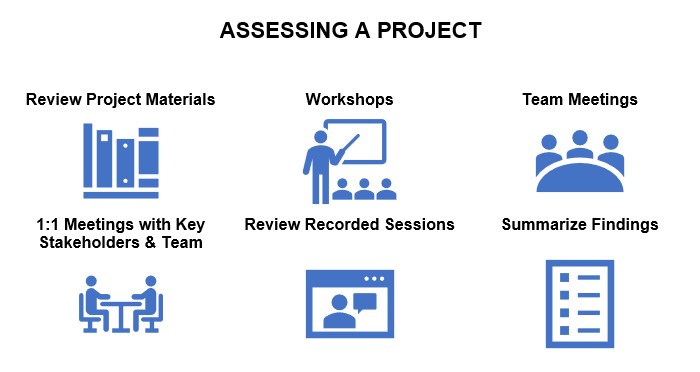
►► OCMS Portal with Project Tool, Template & Project Assessment Checklist ◄◄
Project Assessment Example: How to Perform Your Assessment
Follow the steps below to conduct your project assessment:
1. Schedule meetings with the project sponsor(s), existing project/program managers, project team members, and any relevant stakeholder or SME that is supporting the project.
2. Try to meet each person separately (1-to-1 meetings) versus via group meetings as this allows you to get a more objective and honest assessment of the project from each person’s perspective. If it is not possible to do 1-to-1 meetings, then schedule group meetings with the relevant parties.
3. The agenda for the meetings will be for them to help you understand the background, scale, deliverables, and scope of the project.
4. During the meetings, also ask them about any pain points, concerns, or challenges they might be experiencing. In addition, ask them for a recommended list of other individuals they believe you should meet with as you ramp up on the project.
5. Schedule additional meetings and meet with the individuals on the recommended “meet with” list to help you assess project needs from all sides.
6. When meeting with key project leads, make sure to request essential project documents (e.g., project charter, scope/objective documents, business cases, work breakdown structure (WBS), project timeline, RACI Matrix, and functional decomposition documents).
7. As part of your own project readiness checklist for learning about the project, review all documents to answer the questions listed in the previous section.
8. Summarize and enter your project analysis findings in one of the project assessment tools you’ve chosen to facilitate your work (software, spreadsheet, template). It’s helpful if the tool you use also includes a project risk analysis component based on a reputable change leadership model.
Where can you find a project assessment checklist to guide you through a needs assessment in project management? Try OCMS Portal’s Best Project Assessment Tool.
The OCMS Prosci project change triangle tool substitute offers a project readiness checklist that walks you through the process described above (in more detail!). It also includes a robust project risk & success assessment tool and analytics that rival the Prosci triangle used for the PCT assessment.
OCMS Portal with Business Change Program Assessment, Risk & Success Software
What is a Project Assessment Report?
The information you gather as part of your program analysis will be used extensively in your awareness, communications, and engagement campaigns. This information will also be leveraged in getting you up to speed very quickly when you start planning and delivering your project-based deliverables.
When gathering your project assessment information, you want to have a goal of sharing a comprehensive version – aka a project assessment report – with key project leaders and team members (project sponsors, project lead, change agents and champions, etc.).
This project assessment report should include the things you have learned about the project and that are going to inform your change management for the project.
This report information can be folded into what’s known as the Change Management Strategic Playbook.
Get a free Strategic Playbook Template and project assessment example report here.
Now that we’ve discussed the project assessment meaning and steps for learning about a project, we’ll dive into the next section. This section is dedicated to needs assessment in project management for project risk and success.
Let us know if you have any questions about the project readiness checklist above, the OCMS Portal project model in project management, risk analysis in project management, or a change impact assessment Prosci, OCMS, or another framework describes.
Project Assessments for Project Risk & Success
What Equates to Project Success? Or Project Risk?
The project risk analysis (also known as a project needs analysis), is the type of project assessment that looks at how well a project is going.
You don’t want to wait until the end of the project to learn that there are risk factors due to certain deliverables not being provided. This happens all too often when projects are implemented, but no risk or needs assessment in project management is completed during the project.
This project assessment provides an important “temperature check” during project planning and implementation. It can let the project team and change team know if something needs attention by putting up a red flag BEFORE the project is finished, when it may be too late to make corrections.
To properly conduct this type of project management self-assessment, you need to have an idea of what factors put a project at risk and what factors equal success.
Project Risk Factors include:
- When project deliverables are not being delivered on time
- When change management is not brought in early enough in the project planning
- When the technical solution isn’t well tested before being deployed
- When training isn’t being conducted to properly enable users
- When there is poor communication with impacted stakeholders about the change
- And more…
Project Success Factors include:
- When the project team and change team are coordinating regularly
- When all project deliverables are being delivered on time
- When users are being informed through good communications
- When opposition to the changes the project requires is addressed and resolved
- When users are enabled with both knowledge and proficiency to adopt the new solution
- And more…
Are you leading or responsible for a mid-to-large project implementation? We can help. Learn more about how Airiodion Group can help you and your organization: Top Rated Change Management Consultants.
Learn more about how Airiodion Group can help you and your organization: Top Rated Change Management Consultants.
Is there a best project timeline management assessment that you have used that you would like to share with other project managers and change leads? Please, reach out and let us know.
Why Project Success Hinges on Project Management & Change Management Working Together
When is a project considered successful? When the solution is technically delivered to the users, and it works?
No! But unfortunately, that is how too many project management teams define success. They deliver the solution and then move on to the next project.
So, what else is needed for the project to be successful?
Users to adopt that solution. If you do not have adoption of the new solution by those required to adopt it and incorporate it into their daily workflow, then you do not have project success.
For this reason, it takes “two to tango” when it comes to any project that requires people to change the way they do something. Those two dance partners are Project Management and Change Management.
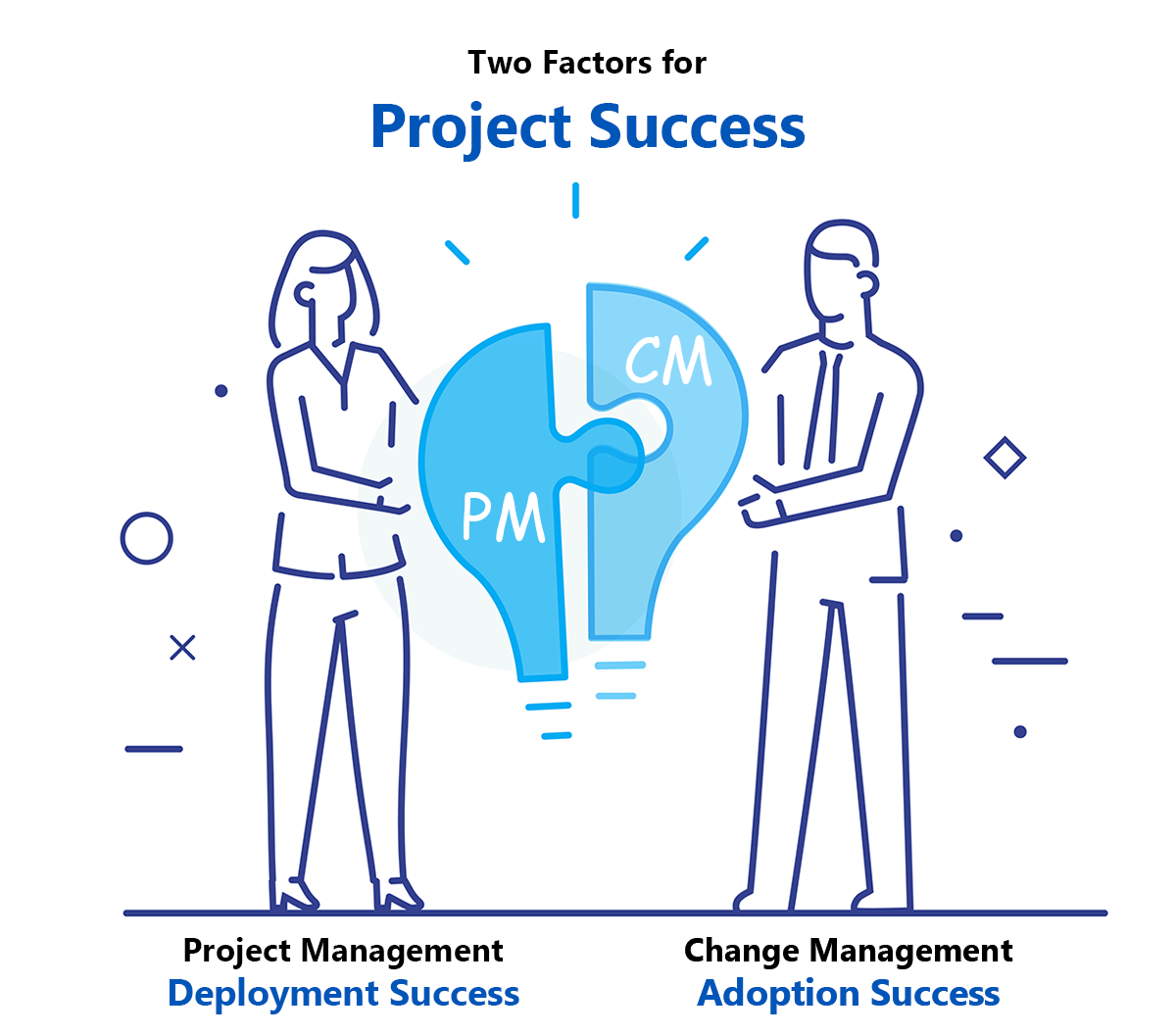
No matter what impact analysis project management framework that you choose to use for project assessment, it should look at both the project deployment facilitated by the Project Management Team and the solution adoption facilitated by the Change Management Team. Unless both are successful, the project itself cannot be considered successful.
Do you have any questions or helpful input related to a project model in project management that includes change management? Are you looking for an alternative to the Prosci project change triangle? Please reach out and let us know.
What is a Project Risk Analysis?
Risk analysis in PMO assessment is the process of monitoring project activities so you can identify risk areas and address them before they become contributors to project failure.
The earlier you can catch a potential problem, the more time you have to correct it and keep the project on track. Without doing a project risk analysis, project managers and change managers can be caught off-guard by issues that it is too late to fix. Or that may take a lot of time to fix, extending the project deadline and throwing off the project timeline management assessment.
Risk analysis, also known as project needs assessment, will typically involve the following process:
- Monitoring & risk assessment
- Risk evaluation
- Risk resolution or mitigation
- Continued monitoring
Using a project evaluation criteria checklist or project assessment tool for this purpose can assist you with comprehensive reporting that makes it easier to spot risk and move to risk resolution.
Project Assessment Examples from the OCMS Portal Project Assessment Analytics
See both high-level and detailed scores for risk throughout the project to inform timely adjustments & decision-making. See the OCMS Portal with Process Assessment Tool & Checklist.
Why is it Important to Assess Project Risk & Success?
We’ve discussed the importance of doing project risk analysis during a project complexity assessment. If you don’t monitor and assess risk, then you can be caught by surprise by problems that can cause a project to fail.
One project assessment example of a risk that can turn into project failure is as follows:
- Risk: The change management team has not yet been invited to any project management meetings and it’s a week before go-live.
- Resulting Failure: The change management team never has a chance to prepare end-users properly for the transition, and users fail to adopt and use the new solution, thus the project fails, even if the new solution was deployed successfully.
Remember, for a project to be considered successful, both the deployment of the project solution and adoption of that solution by the people that need to adopt it must be successful.
Why also look for successes when using a change leadership model to assess how a project is going?
Because if you only look at risk, then you’re missing things you can leverage for success in other areas of this project or the next project.
When choosing one of the project assessment examples of assessment tools, like the program management triangle or an equivalent to the PCT assessment Prosci uses, look for reporting analytics that show risk and success.
When you identify successes as well as risks, it provides a more robust project assessment meaning. Instead of the project assessment only focusing on the negative, it’s also focusing on the positive.
This provides a more holistic and balanced view. Project management leaders are also generally more open to hearing about potential problems from the change management team if they’re also presented with good news about areas of the project that are going well.
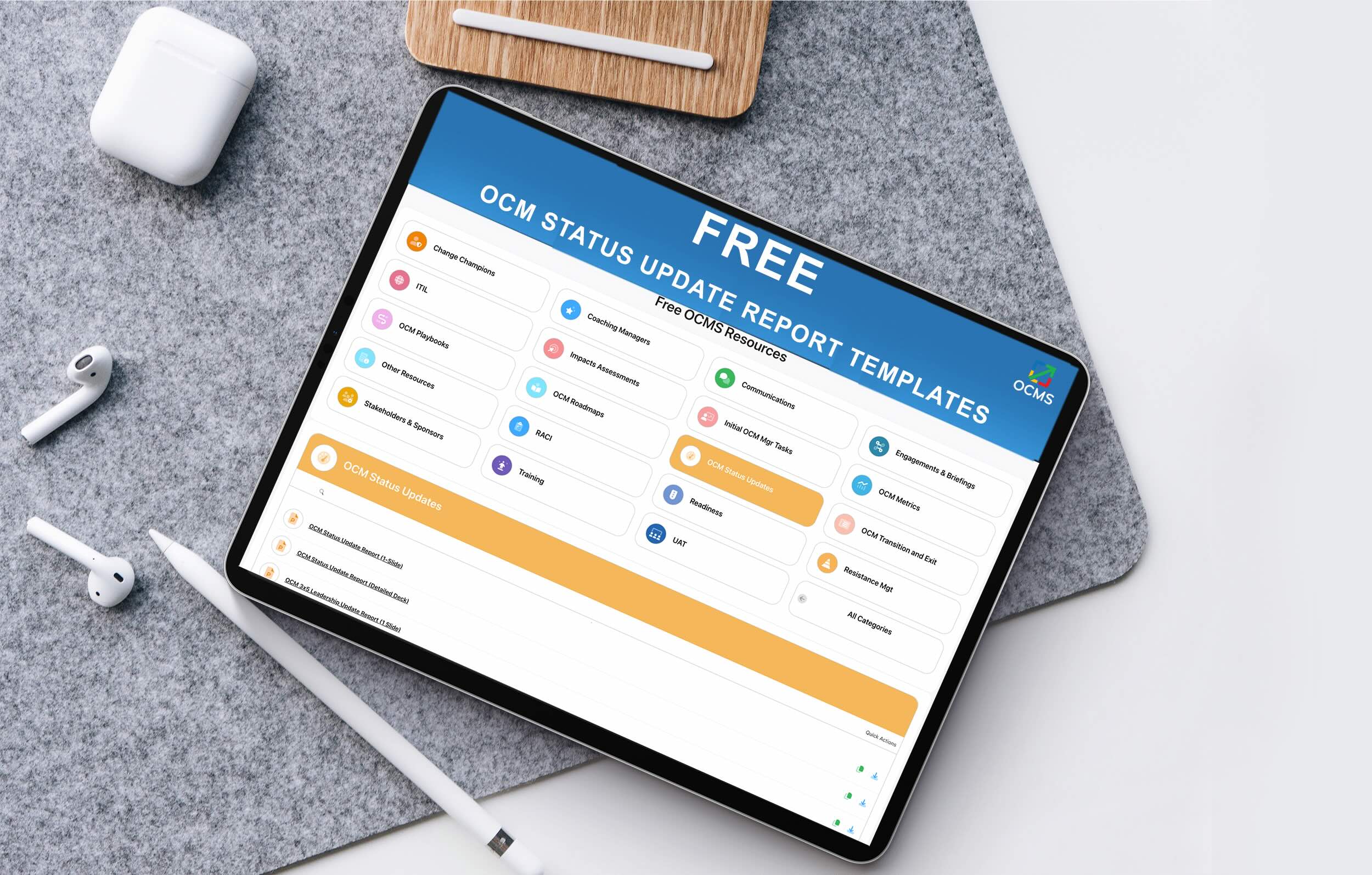
Get access to over 100 free templates, when you sign up for an OCMS Portal Trial, including status update reports for project risk assessment updates.
Do you have any questions about this article on project management assessment, our project assessment examples, project risk management examples, or the OCMS Portal assessment tool alternative to Prosci PCT management? Please reach out and let us know.
When Should You Assess a Project for Risk & Success?
The frequency of assessment for risk and success using a project evaluation criteria checklist will vary according to project size and scope. Additionally, any requirements dictated by the project risk analysis or change leadership model you’re using may indicate specific assessment milestones.
OCMS’ team of change management experts recommends three key assessment points. These are critical milestones in the project timeline where you should check in with a project to ensure that both the solution deployment and user adoption are on the right track.
We recommend performing project assessments for risk & success at these stages:
- Stage 1: Readiness & Assessment
(Before creating the change management plans)
- Stage 2: Planning & Deployment
(Before the “go-live” date for the solution)
- Stage 3: Post-Go-Live Normalization
(After the “go-live” date for the solution)
In the next section of this impact analysis project management article, we are going to explain each of those three stages in more detail.
How to Do a Risk/Success Needs Assessment in Project Management in 3 Stages
The goal of doing the risk & success project needs assessment is to identify any potential risk areas early so issues can be addressed. As well as see what is going well, so those successful facets of the project can be incorporated as possible into other areas of the project and future projects.
The project assessment is most helpful when it’s focused on project deliverables. These are the things that the project management team and change management team need to deliver for the project to be completed successfully.
A deliverable can be a change management communications plan. It can also be a meeting schedule that the project team provides so the change manager can join important project meetings.
When you assess a project, you want to look at what deliverables have been completed and which are still pending. If some are missing (such as a training plan), this can indicate an area of risk to the project.
The project assessment examples that you identify as risks to project success are jumping-off points. These can drive conversations that the change management and project management teams can have together or that the change management team needs to have with project sponsors.
For example, showing a project sponsor that the project’s Stage 1 risk score is showing “High Risk,” and which deliverables are still outstanding and causing that score provides important and actionable information.
Following, we’ll go through the three stages of project assessments in the OCMS Portal’s Project Assessment, Risk & Success Tool. This change leadership model for assessment is an alternative to the Prosci change triangle (also known as the Prosci PCT model).
The OCMS Portal project needs assessment framework looks at the deliverable contributions of both the deployment side of the project (project management) and the adoption side of the project (change management) as well as vital activities, such as assessment and change management deployment.
Success & Project Risk Analysis
Stage 1: Readiness & Assessment
The project management self-assessment done in stage one is performed before creating the change management plans. This is the first stage of a project when both the project team and the change management team are first becoming familiar with the project.
To give a project assessment meaning at this stage, you will look at deliverables related to laying the groundwork for the project to succeed.
You’ll be assessing whether the following deliverable areas are being completed:
- Project Documentation (E.g., Is there a project charter? Has this been shared with the change management team? Is there a project timeline?)
- Goals & Metrics (E.g., Are project goals clear? Are metrics set up to measure these goals?)
- Team Assessment (E.g., Is team leadership in place for both change management and project management?)
- Project Management & Change Management (Has the Change Manager been invited to have a seat at the table? Does the project manager understand the need for change management?)
- Tools & Apps (E.g., Are digital tools in place to facilitate the management of the project deployment and adoption?)
- Sponsors (E.g., Are there clearly defined sponsors, and are they supporting the project?)
- Change Management Assessments (E.g., Has the change impact assessment been done? Readiness assessment?)
Stage 2: Planning & Deployment
When using project assessment tools, like the Prosci triangle or an equivalent to the change impact assessment Prosci PCT, you’ll want to assess how the planning and deployment of the project are going after the readiness and assessment stage and before the project is deployed.
This is one of the most critical stages because it’s in this stage that awareness, communications, and enablement need to occur to ensure that those being impacted by the change are ready to adopt the new expected “future state” or solution.
This project risk analysis and success assessment should be done before the “go-live” date for the project.
You’ll be assessing whether the following deliverable areas are being completed:
- Planning (E.g., Has the project plan been developed and delivered? Is the change management plan completed?)
- Communications (E.g., Have milestones been communicated? Is the communications plan completed?)
- Task Monitoring (E.g., Are tasks being tracked? Is ongoing reporting being delivered?)
- Project Management & Change Management (E.g., Are the project and change management teams coordinating on deliverables?)
- Go-Live Readiness (E.g., Is go-live readiness being monitored? Have end-users been trained?)
- Change Management Deployment (E.g., Is the communications plan being deployed? Are change metrics being tracked?)
Stage 3: Post-Go-Live Normalization
The needs assessment in project management that is done in the third stage is designed to ensure that the solution is being adopted and end-users are being supported.
Remember, a project cannot be successful unless the behaviors and actions required by those being impacted by a change are actually adopted and normalized. Post-go-live support is critical to ensuring that changes needed for the project solution to be successful are sustained for the long-term and evolve into the new “way of doing things.”
This assessment, which is done after the “go-live” date looks at the support component and ensures that project managers, sponsors, and others aren’t walking away from the project too soon because they assume it’s completed.
You’ll be assessing whether the following deliverable areas are being completed:
- Post-Go-Live Tracking (E.g., Is there a way to track user issues with the new solution post-go-live?)
- Issue Resolution (E.g., Is there adequate personnel to resolve issues that users bring up after they begin using the solution?)
- Post-Go-Live Support (E.g., Are there enough support resources for impacted end users? Is additional training available?)
- Project Management & Change Management (E.g., Are the change and project management teams working together to ensure normalization of required changes? Have they met to look at lessons learned?)
- Closure (E.g., Are resources being transferred to permanent owners? Has project-end “housekeeping” been completed?)
- Normalization (E.g., Is new resistance being monitored for and addressed? Are impacted groups using the new solution successfully?)
Do you have any questions about project assessment tools in general or alternatives to the program management triangle approach? Please reach out and let us know.
OCMS Portal – Automated Software for Simple & Insightful Project Assessments
The OCMS Portal Project Assessment, Risk & Success Tool provides you with a powerful, yet simple-to-use tool for assessing your project for risk and success.
It includes a comprehensive scoring system and an informative analytics dashboard. Our analytics not only provide you with a score based on the deliverables that you’ve indicated are completed (or not), but also insights into what that score means. Use this explanation to drive the conversation with the Project Manager, Project Lead, project sponsors, or the Change Management Team.
This one-of-a-kind tool for project assessments facilitates both types of assessments often found on a project evaluation criteria checklist:
- Project assessment to learn about the project; and
- Project assessment for risk & success

Project Assessment Tool & End-to-End OCM Tools – Start Your Trial Today
Conclusion – Project Assessment Example & Metrics
When using a change leadership model to conduct change management support for a project, a project risk analysis must be performed at critical stages during project assessment, deployment, and normalization.
This assessment should be a combination of a project management assessment and a change management assessment. This way, you can track both halves of the whole that are required to succeed for a project to be successful – solution deployment and solution adoption.
We hope that this guide and these project assessment examples have been helpful to you as you work to facilitate successful projects and change management support.
If you’d like to know more about the OCMS Portal’s Project Assessment Tool or want to join a webinar to see a walkthrough of this alternative to the Prosci PCT assessment template, please reach out and let us know!
FAQ: Project Evaluation Criteria Checklist & Guide
What is a Project Assessment?
A project assessment is an end-to-end analysis of a project's scope, scale, deliverables, objectives, and impacts. It also involves assessing the project's stakeholders, risks, timeline, and impacted groups and processes.
Why is Project Assessment Important?
A project complexity assessment is important at the start of a project so the change management team can be informed about the project timeline, stakeholders, scope, milestones, and other details.
When the project begins, then project assessments should be done to proactively identify areas of risk as well as find areas of success to learn from.
How Do You Evaluate Project Performance?
The OCMS change leadership model, which is used for the OCMS Portal Project Assessment Template, uses deliverables to evaluate project performance.
There are specific deliverables that need to be provided from both the deployment (project management) and adoption (change management) parts of a project. If these deliverables are missing, this indicates the risk that a project could fail to meet its objectives.
What are Project Performance Indicators?
Project performance indicators fall both on the technical solution deployment side and the people-centric solution adoption side.
For example, a project solution being thoroughly tested and passing user acceptance testing is one positive performance indicator.
Another indicator of project performance is whether or not the solution being launched is being adopted by those required to do so. Even if a project has technically been deployed successfully, if you do not have adoption by end-users, then you do not have project success.
Do you need change management consulting support or help?
Contact Airiodion Group, a specialist change management consultancy that supports organizations, project managers, program leads, transformation leaders, CIOs, COOs, and more, who are navigating complex transformation initiatives. For general questions, contact the OCM Solution team. All content on ocmsolution.com is protected by copyright.
External image sources:
- stock.adobe.com
- https://www.ls.graphics/free/free-pixel-4-and-pixelbook-go-mockup




